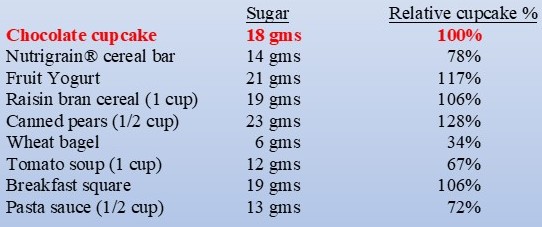
Simple Dietary Measures to Look at to Ensure a Healthy Diet
The discussion of the changes to our diet over the past 100 years that are driving the many chronic diseases common in society can be complex. However, there are a few indicators which are key and relatively easy to look at. Perhaps the most important indicator is the sugar to fiber ratio or sugar:fiber. A healthy, whole food diet should supply approximately 40% of the caloric energy from carbohydrate.
Interestingly, if the carbohydrate is whole (complex) and healthy it will provide about 35-40 grams of sugar and 35-40 grams of fiber which is a 1:1 sugar to fiber ratio. The Western dietary pattern which is the standard American diet appropriately dubbed the SAD diet has a sugar to fiber ratio of between 8:1 and 10:1. The cause is a combination of too much sugar and not enough fiber. Fiber is a victim of processing, and sugar is added as it drives the area of the brain that regulates desire for consumption.

Natural sugars in complex carbohydrates are in chains called polysaccharides. These chains cannot be absorbed through the intestinal wall until digestive enzymes break the bonds separating them into individual sugars. Fiber is non-digestible and slows the rate at which the digestive enzymes can contact and break the bonds between sugars allowing them to be absorbed. The result is a very gradual raising of blood sugar over 3-4 hours while digestion occurs.
As the blood glucose is increased gradually over 3-4 hours all of this can be burned up as cell energy.

In contrast a refined carbohydrate, where the fiber has been reduced by processing and sugar is added to drive consumption, requires little to no digestion and the simple sugars are rapidly absorbed in the first hour. As this rapid supply of sugar exceeds cell energy needs, the extra is processed in the liver to a storage form of energy, the fat triglyceride. The triglyceride is stored in the belly and central part of the body.
While both of these carbohydrates are the same number of grams, one gets all used as energy and the other mostly stored as disease causing belly fat. It seems all carbohydrates are not created equal.
One of my favorite lay lectures is “ How Healthy Would You Be Eating 15 cupcakes Each Day?”. When that question is posed to the audience, the responses are generally not healthy at all. I then show the grams of sugar and fiber in a cupcake. At 22 grams of sugar and 1 gram of fiber this ratio is 22:1!



From there I go through many of the foods that are often a common part of everyday diets and based on the sugar content rate them on the “cupcake scale”. For example standard fruit-in-the-bottom yogurt has 21 grams of sugar giving it a rating of 117% of that of the cupcake. When we build a day of eating mostly refined carbohydrate, the sugar content is that of 12-15 cupcakes.
By law foods are required to have a box “Nutritional Facts” which shows the grams of sugar and the grams of fiber in a serving of that food. Taking a quick glance at that and noting the sugar to fiber ratio can be a great way to know how to improve food choices. After all, how healthy would you be eating 15 cupcakes each day?